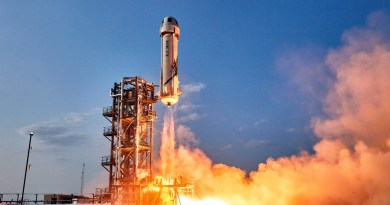New Shepard Suffers First Launch Failure

After an initially clean liftoff from Blue Origin’s Launch Site One in Van Horn Texas, an uncrewed New Shepard suffered an anomaly just over a minute into flight. This was the first ascent failure for the New Shepard rocket, ending a 22 launch and 21 landing success streak. The capsule, RSS H.G. Wells, survived the anomaly by utilizing its launch escape system, while the NS3 booster was lost.
Liftoff had been scheduled for 8:30 AM CDT, but a pair of holds at T-15 minutes and T-3 minutes and 30 seconds delayed the launch to later in the window. After the countdown resumed and final fin and vehicle checks were complete, New Shepard mission NS-23 lifted off at 9:27 AM CDT.
The initial liftoff looked clean, as the vehicle pitched away from its umbilical tower and climbed for a target altitude of approximately 105km. Just after a minute into flight, the exhaust plume on the BE-3 began to exhibit anomalous behavior, shifting from its typical clear exhaust, to an orange flame behind the launcher. Moments later, at T+1:04, a flash was observed in the boat tail of the booster, followed by the vehicle losing control, and pitching into the airstream.
At that moment the Launch Abort System (LAS) fired on the New Shepard Capsule (RSS H.G. Wells), pulling the uncrewed science vessel away from the failing booster. Data from the booster shown on the live stream just before impact indicated the booster impacted at approximately 300 mph. The FAA confirmed that after the failure “the booster impacted within the designated hazard area.” No injuries, or public property damage, has been reported from the incident.
After firing its LAS the capsule reached approximately 11.3 km above sea level, before descending back to Earth. It successfully fired its drogue, and then main parachutes, safely landing in the desert after its shortened flight.
At this time we do not know what caused the failure of the New Shepard booster, however we do know the Launch Abort System functioned as expected, safely pulling the payload away and returning the capsule to the ground safely. The FAA will be leading the investigation into the launch failure, with Blue Origin stating that they will provide updates to the failure as they become available.
Edited by David Diebold, Lavie Ohana



